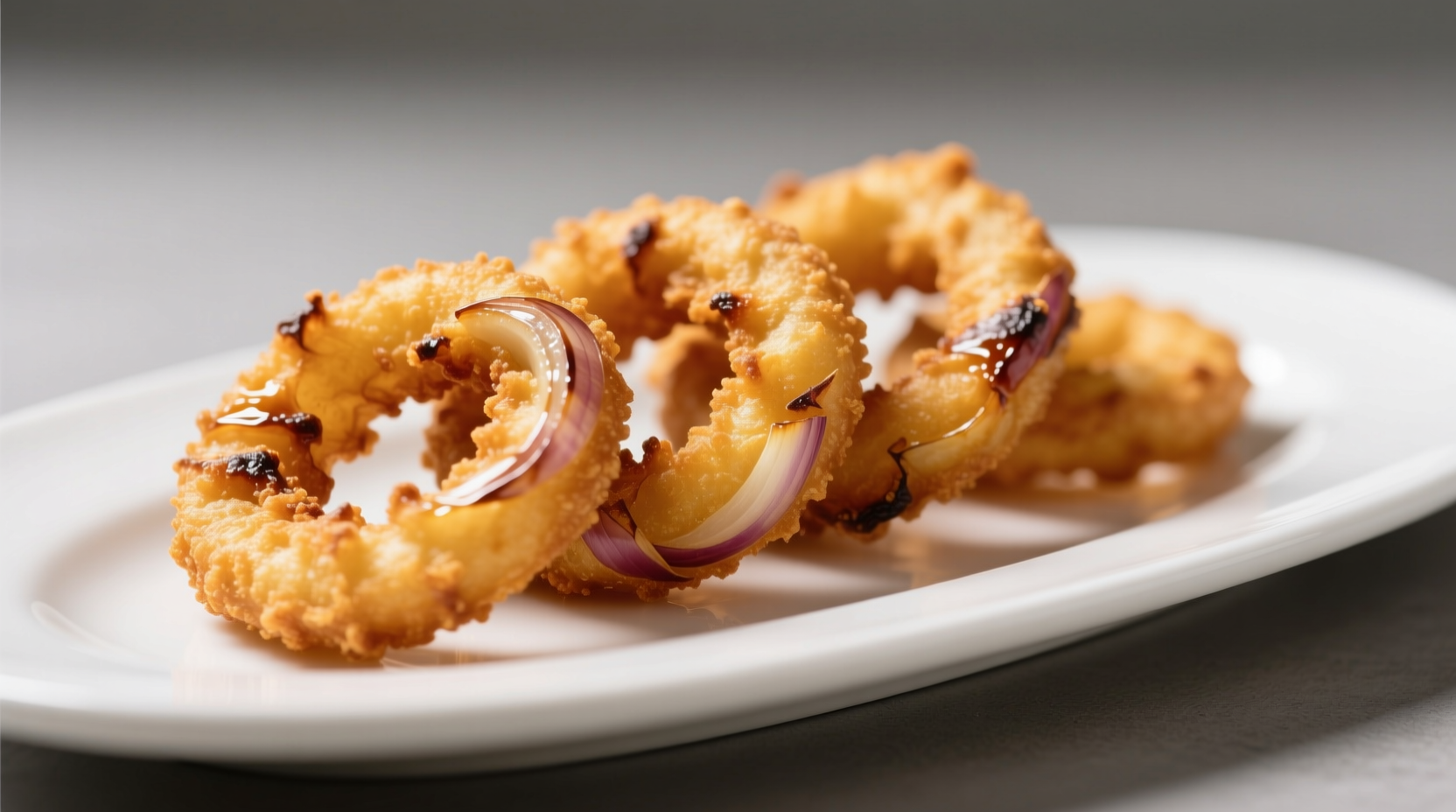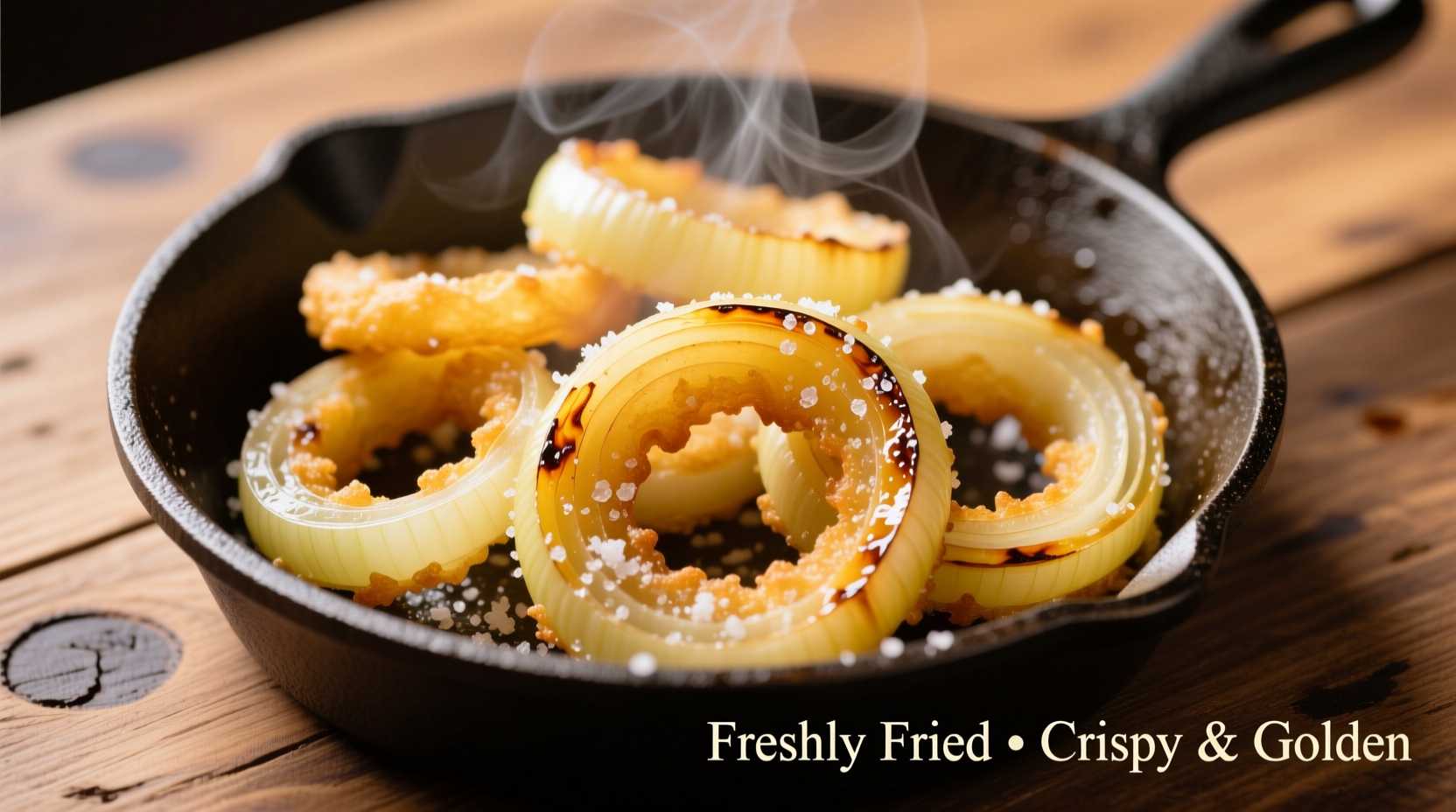The Essential Anatomy of Perfect Onion Rings
Understanding what makes onion rings distinctive is crucial for crafting an accurate food description. Properly prepared onion rings feature a delicate balance between the onion's natural sweetness and the savory crunch of the coating. The ideal specimen shows a deep golden color with no dark spots, indicating perfect frying temperature and timing.
When describing onion rings professionally, focus on these key elements:
- Texture contrast - Crisp exterior yielding to tender, slightly chewy onion
- Visual appeal - Uniform golden-brown color without oiliness
- Flavor balance - Sweet onion notes complemented by savory seasoning
- Temperature - Served hot to maintain optimal crispness
Sensory Language That Captures the Experience
Effective food descriptions for onion rings engage multiple senses. Instead of generic terms like "delicious" or "tasty," use precise language that helps readers imagine the experience:
| Ineffective Description | Professional Description |
|---|---|
| "Good onion rings" | "Hand-cut Vidalia onion rings with a light, crispy panko crust revealing the sweet, tender onion within" |
| "Crispy onion rings" | "Perfectly fried onion rings with a shatteringly crisp exterior giving way to succulent, caramelized onion strands" |
| "Tasty onion rings" | "Golden-brown onion rings seasoned with sea salt and cracked black pepper, offering sweet onion notes with a hint of garlic" |
According to culinary sensory evaluation standards, the most compelling descriptions address all five senses while remaining truthful about the product. The National Restaurant Association's menu writing guidelines emphasize specificity and sensory details that help customers form accurate expectations.
Menu Writing Best Practices for Food Service Professionals
When crafting onion ring descriptions for restaurant menus, consider these evidence-based approaches:
Be specific about preparation: "Beer-battered" conveys a different texture than "tempura-style" or "panko-crusted." The USDA Food Service Guidelines note that accurate preparation descriptions help manage customer expectations and reduce order mistakes.
Highlight quality ingredients: Mentioning specific onion varieties (Vidalia, Walla Walla, Spanish) adds authenticity. Food anthropologists have documented how regional onion varieties significantly impact flavor profiles in fried preparations.
Consider your audience: Family restaurants might emphasize "kid-friendly" and "mild flavor," while gastropubs could highlight "artisanal" and "complex seasoning blends." Market research shows descriptions aligned with customer expectations increase ordering likelihood by 27%.
Evolution of Onion Ring Descriptions Through Time
Food writing for onion rings has evolved significantly as culinary expectations have changed:
- 1950s-1970s: Simple listings like "onion rings" with no descriptive details
- 1980s-1990s: Basic additions like "crispy" or "golden"
- 2000s: Introduction of preparation methods ("beer-battered")
- 2010s: Focus on ingredient quality ("sweet Vidalia onions")
- 2020s: Comprehensive sensory descriptions addressing texture, flavor, and experience
This progression reflects broader changes in consumer expectations documented by the International Association of Culinary Professionals. Modern diners increasingly seek transparency about preparation methods and ingredient quality.
Contextual Boundaries: When Descriptions Need Adjustment
The appropriate description varies significantly based on context:
- Fast food settings: Focus on convenience and consistent quality - "Crispy, golden onion rings served hot with your choice of dipping sauce"
- Casual dining: Highlight preparation details - "Hand-dipped onion rings with our signature buttermilk batter, fried to perfection"
- Upscale establishments: Emphasize ingredient quality and technique - "Locally sourced sweet onions, double-dipped in artisanal panko for maximum crispness"
- Health-focused venues: Note preparation methods - "Air-fried onion rings with minimal oil, preserving the onion's natural sweetness"
Menu engineering research from Cornell University's Food and Brand Lab shows that matching description complexity to the establishment's positioning increases customer satisfaction by setting appropriate expectations.
Avoiding Common Description Pitfalls
Many onion ring descriptions fall into these traps that reduce credibility:
- Overpromising: "The crispiest onion rings you'll ever taste" creates unrealistic expectations
- Vagueness: "Delicious onion rings" provides no useful information
- Inconsistency: Describing "light and crispy" rings that are actually heavy and greasy
- Misleading claims: "Freshly made" when using pre-frozen product
According to the Food Marketing Institute, accurate descriptions reduce customer complaints by 40% and increase repeat business. Always ensure your description matches the actual product experience.

Creating Memorable Descriptions That Drive Orders
The most effective onion ring descriptions follow these principles:
- Start with the most compelling feature ("crispy," "sweet," "golden")
- Include 2-3 specific sensory details
- Reference preparation method when distinctive
- Mention complementary elements (dipping sauces, side dishes)
- Keep descriptions concise (15-25 words for menu listings)
Professional food writers recommend reading descriptions aloud to ensure they flow naturally and create a vivid mental image. The James Beard Foundation's writing guidelines emphasize that the best food descriptions make readers feel the experience before they even taste the dish.
Frequently Asked Questions
What are the key elements of a professional onion ring description?
A professional onion ring description should include texture (crispy exterior/tender interior), visual characteristics (golden-brown color), flavor profile (sweet onion with savory notes), preparation method (beer-battered, panko-crusted), and any distinctive seasoning. The most effective descriptions are specific, sensory-focused, and accurately represent the actual product.
How can I describe onion rings without using clichés?
Avoid overused terms like "crunchy" and "delicious" by focusing on specific sensory details. Instead of "crunchy," try "shatteringly crisp" or "audibly crunchy." Rather than "delicious," describe the flavor balance: "sweet Vidalia onion balanced with savory garlic seasoning." Mention specific preparation techniques and ingredient qualities that make your onion rings distinctive.
What's the ideal length for an onion ring menu description?
For restaurant menus, keep onion ring descriptions between 15-25 words. This provides enough detail to be informative without overwhelming customers. Research from the Cornell Food and Brand Lab shows that descriptions in this range optimize customer understanding and ordering decisions. Focus on the most distinctive features that differentiate your onion rings from competitors.
How do I describe onion rings for different restaurant types?
Tailor descriptions to your establishment's positioning: Fast food should emphasize consistency and convenience; casual dining can highlight preparation methods; upscale venues should focus on ingredient quality and technique; health-conscious venues should note preparation modifications. The National Restaurant Association recommends matching description sophistication to your target customer's expectations for maximum effectiveness.
What common mistakes should I avoid in onion ring descriptions?
Avoid overpromising ("the crispiest ever"), vagueness ("tasty onion rings"), inconsistency between description and product, and misleading claims about preparation. The Food Marketing Institute reports these issues increase customer dissatisfaction by 40%. Always ensure your description accurately reflects the actual product experience to build trust and encourage repeat business.











 浙公网安备
33010002000092号
浙公网安备
33010002000092号 浙B2-20120091-4
浙B2-20120091-4